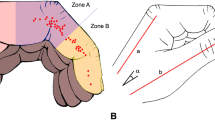Abstract
Purpose
To assess patient satisfaction, functional and cosmetic outcomes of single-digit ray amputation in hand and identify factors that might affect the outcome.
Methods
Forty-five patients who underwent ray amputation were evaluated, 37 males and eight females whose mean age was 36.6 years ranging between 15 and 67 years. Twenty-eight patients had dominant hand involvement. Twenty-one patients underwent primary ray amputation, and 24 patients had secondary ray amputation. Eight out of the 23 patients with central digit injuries underwent transposition. Grip strength, pinch strength, tactile sensibility and functional evaluation using Result Assessment Scale (RAS) and DASH score were analysed. Cosmetic assessment was performed using visual analogue scale (VAS) for cosmesis.
Results
Median time of assessment after surgery was 20 months. Average loss of grip strength and pinch strength was found to be 43.3 and 33.6%, respectively. Average RAS score was 3.75. Median DASH score was 23.4. Eighty-three percentage of patients had excellent or good cosmesis on the VAS. Transposition causes significant increase in DASH scores for central digit ray amputations but was cosmetically superior. Middle finger ray amputation had the maximum loss of grip strength, and index finger ray amputation had greater loss of pinch strength. Affection of neighbouring digits caused greater grip and pinch loss, and a higher DASH score. Primary ray resection decreased the total disability and eliminated the costs of a second procedure.
Conclusion
Following ray amputation, one can predict an approximate 43.3% loss of grip strength and 33.6% loss of pinch strength. The patients can be counselled regarding the expected time off from work, amount of disability and complications after a single-digit ray amputation. Majority of the patients can return to the same occupation after a period of dedicated hand therapy.
Level of Evidence
Therapeutic, Level III.




Similar content being viewed by others
References
Peimer CA, Wheeler DR, Barrett A, Goldschmidt PG (1999) Hand function following single ray amputation. J Hand Surg Am 24A:1245–1248
Mahoney JH, Phalen GS, Frackelton WH (1947) Amputation of the index ray. Surgery 21(6):911–918
Bunnell S (1931) Physiological reconstruction of a thumb after total loss. Surg Gynecol Obstet 52:245–248
Bunnell S (1924) Reconstructive surgery of the hand. Surg Gynecol Obstet 39:259–274
Swanson AB, Goran-Hagert G, De Groot Swanson G (1984) Evaluation of impairment of hand function. In: Hunter JM, Schneider LH, Mackin EJ, Callahan AD (eds) Rehabilitation of the hand, 2nd edn. St. Louis, The CV Mosby Co, pp 101–132
Carrol RE (1959) Transposition of index finger to replace the middle finger. Clin Orthop 15:27–34
Iselin F, Peze W (1988) Ray centralization without bone fixation for amputation of the middle finger. J Hand Surg Br 13B:97–99
Calandruccio JH (2007) Amputations of the hand. In: Canale ST, Beaty JH (eds) Campbell’s operative orthopaedics, 11th edn. Mosby Inc, Philadelphia, pp 685–690
Colen L, Bunkis J, Gorden L, Walton R (1985) Functional assessment of ray transfer for central digit loss. J Hand Surg Am 10A(2):232–237
Jester A, Harth A, Wind G, Germann G, Sauerbier M (2005) DASH questionnaire, determining functional activity profiles in patients with upper extremity disorders. J Hand Surg Br 30B(1):23–28
Choughri H (2005) Results of secondary single ray resection without transposition of an adjacent digit. Eur J Orthop Surg Traumatol 15:300–308
Sood MK, Elliot D (2000) Amputation of the middle ray in the primary treatment of severe injuries of the central hand. Plast Reconstr Surg 106(1):115–118
Puhaindran ME, Healey JH, Athanasian EA (2010) Single ray amputation for tumors of the hand. Clin Orthop Relat Res 468(5):1390–1395
Murray JF, Carman W, MacKenzie JK (1977) Transmetacarpal amputation of the index finger: a clinical assessment of hand strength and complications. J Hand Surg Am 2A:471–481
Author information
Authors and Affiliations
Corresponding author
Ethics declarations
Conflicts of interest
There are no conflicts of interest for the authors to declare.
Ethical approval
Institutional ethical committee approval was obtained for the study.
Rights and permissions
About this article
Cite this article
Bhat, A.K., Acharya, A.M., Narayanakurup, J.K. et al. Functional and cosmetic outcome of single-digit ray amputation in hand. Musculoskelet Surg 101, 275–281 (2017). https://doi.org/10.1007/s12306-017-0484-x
Received:
Accepted:
Published:
Issue Date:
DOI: https://doi.org/10.1007/s12306-017-0484-x




